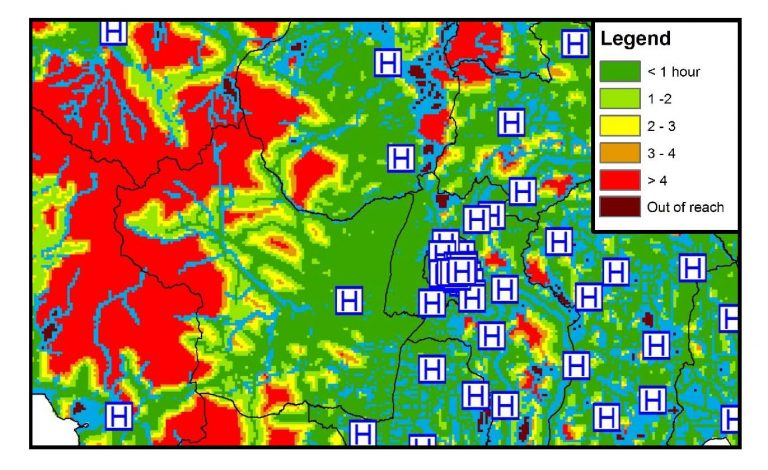According to the World Health Organization’s (WHO) key facts on maternal mortality [1], 99% of all maternal deaths occur in developing countries while most of the health-care solutions to prevent or manage complications leading to deaths are known.
To reduce maternal deaths, it is important to identify and address barriers that limit access to quality health services. One dimension to consider is physical accessibility to health services. Particularly important for addressing maternal and newborn mortality is access to emergency obstetric and newborn care (EmONC) services.
To help countries plan and monitor EmONC services, the international community came up with a set of standard indicators in 2009[2]. While these indicators have been useful for assessing quality and utilization of EmONC services, they do not account for the travel time required by the population to access health services, and thus fail to measure timely access.
To address this gap, a group of practitioners and researchers came together to define three geographically explicit indicators based on country experiences that would complement those included in the 2009 handbook.
These new indicators take advantage of the increased use of geographical information systems, availability of free geographical modelling tools, and the availability of quality geographical data to measure the proportion of:
- Pregnant women able to access EmONC health facilities (Basic emergency obstetric and newborn care (BEmONC) or comprehensive emergency obstetric and newborn care (CEmONC)) within a given travel time;
- Pregnant women able to access CEmONC health facilities within a given travel time; and
- Referral linkages between the considered BEmONC facilities and their nearest CEmONC facility for which the travel time is below a set threshold.
The justification for these indicators, with associated analyses and examples, have been recently published[3] in a supplement of the BMJ Global Health journal dedicated to the use of geospatial data and analytics to guide reproductive, maternal, newborn, child, and adolescent health programs.[4]
By using these indicators, countries can assess whether EmONC services are physically accessible to pregnant women. The results should guide the development of locally appropriate strategies, plans and programmes to improve timely access to quality care in the overall context of advancing Universal Health Coverage and prevent preventable deaths as part of the SDG 2030 targets. A particularly relevant application of the new set of indicators is to support countries identify their national network of designated EmONC health facilities as the geographical location of these health facilities and the travel time to access them should be key considerations to inform such a network. In a situation of limited resources, a subset of EmONC facilities that together provide high population coverage within two hours travel of time (corresponding to the average time between onset of untreated severe postpartum hemorrhage -a leading cause of maternal death- and death) should be identified and efforts should be made to improve their functionality and quality of care.
The newly developed set of indicators provide a road map for countries to address access to quality health care. We look forward to their application across multiple settings and to see them incorporated in future global EmONC monitoring frameworks.
